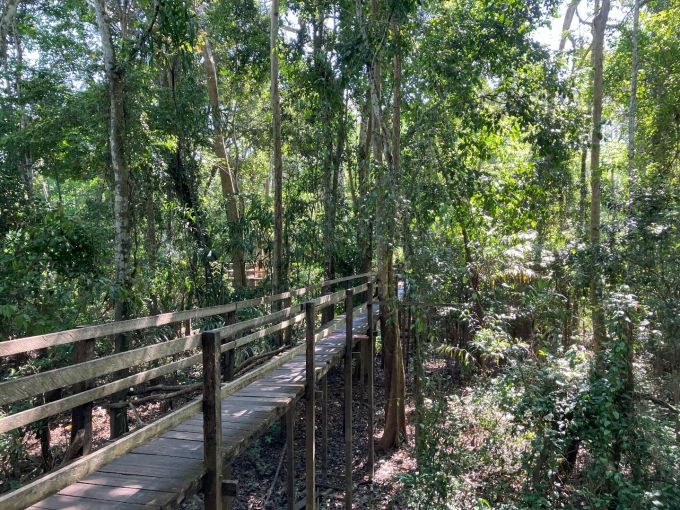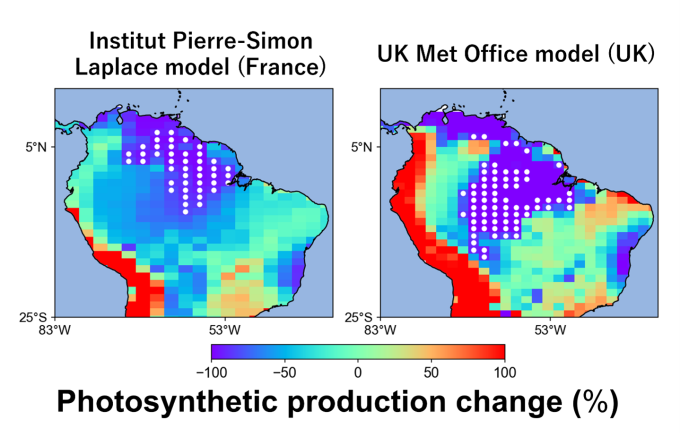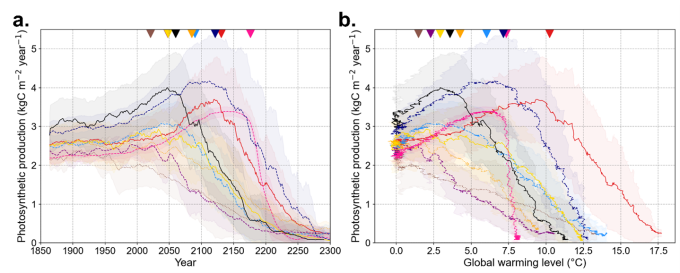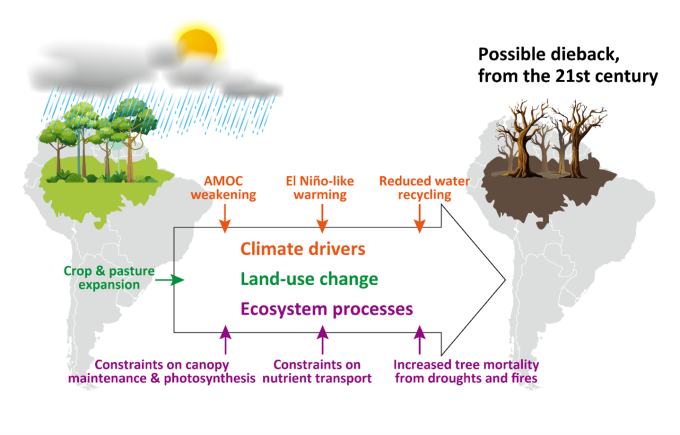
The Amazon dieback may start within the 21st century under high-emission scenarios
1. Background and research motivation
The Amazon is the world's largest rainforest. It harbors immense biodiversity and plays a crucial role in the global climate system by storing vast amounts of carbon in its vegetation (Figure 1). The Amazon is widely recognized as a major climate tipping element note 1 (IPCC: Intergovernmental Panel on Climate Change). Continued deforestation and climate change could push the system past a critical threshold, causing the Amazon to shift from rainforest rich in biodiversity to a degraded savannah-like ecosystem. A new study, published in Communications Earth & Environment, explores long-term future projections of the Amazon ecosystem using state-of-the-art Earth System Models note 2.

2. Methods
Researchers assessed long-term changes in the Amazon rainforest from the present through the year 2300 using the state-of-the-art Earth System Models from the Coupled Model Intercomparison Project (CMIP5 and CMIP6), which informed the IPCC’s Fifth and Sixth Assessment Reports nots 2,3. They defined “dieback” note 3 as severe loss of photosynthetic activity by the end of the 23rd century compared to the 19th century in areas that were originally highly productive, under, under high-emission scenarios (Figure 2). The scientists then analyzed the climatic and ecological conditions under which such drastic shifts could occur.

3. Results
The majority of considered models project Amazon dieback, although the timing and spatial extent vary across models (Figures 2 and 3). The results of Earth System Model simulations suggest that the dieback could begin as early as the 21st century under a wide range of global warming levels, starting from 1.5°C and triggered by extreme conditions—large increases in the annual surface air temperatures, decreases in precipitation and intensified by land-use change from forest to agricultural lands (Figure 3). However, current Earth System Models may underestimate future risks, as many do not fully represent key ecological processes in tropical forests, such as fire dynamics and drought-induced tree mortality.

The new study also uncovers the key mechanisms behind Amazon dieback (Figure 4). Over the long term, global warming weakens the Atlantic Meridional Overturning Circulation (AMOC) note 4, a major system of ocean currents, which in turn shifts the Intertropical Convergence Zone (a vital tropical rain belt) southward. This shift results in hotter and drier conditions across the northern Amazon. Furthermore, rising carbon dioxide levels reduce evapotranspiration, the process by which trees release moisture into the air, thereby weakening the Amazon’s natural water recycling system and contributing to regional drying. In addition, long-term projections under high-emission scenarios show more frequent El Niño note 5–like warming patterns, which intensify heat and drought across the basin. While previous studies have examined warming patterns, circulation shifts and ecosystem impacts, this study is the first to demonstrate Amazon dieback across multiple Earth System Model projections and to explain its underlying drivers.
These climatic changes set off a cascade of ecological disruptions. Hotter and drier conditions reduce the efficiency of photosynthesis and increase plant respiration, tipping the rainforest’s carbon balance. Declining rainfall and soil moisture limit water availability and hinder nutrient transport, stressing tree health and regeneration. As a result, tropical forest ecosystems become less productive, more vulnerable to disturbance, and eventually cross a threshold beyond which they can no longer sustain dense vegetation. Combined with widespread land-use change, especially in the southern Amazon, these shifts push the region toward large-scale ecosystem collapse.

4. Prospects
The study’s findings highlight the urgent need to limit greenhouse gas emissions and protect the Amazon’s resilience. Continued warming, land-use change, and ecosystem degradation could soon push the rainforest past a tipping point, with global climate consequences. The lead author Dr. Irina Melnikova, also cautions that future research should focus on improving the representation of ecological processes in models to better anticipate the risks. Protecting the Amazon requires coordinated international action, integrating climate mitigation, sustainable land management, and conservation strategies.
5. Annotations
Notes
1 A tipping element is a component of the Earth system — such as the atmosphere, ocean currents, or ecosystems — that can shift abruptly into a different state when pushed beyond a critical threshold. This threshold is known as a tipping point. Once crossed, it can lead to rapid, irreversible, and self-sustaining changes in the system. From the Global Tipping Points Report 2023 (https://report-2023.global-tipping-points.org/).
2 Earth System Models are advanced tools that simulate the complex interactions between the atmosphere, ocean, land, and biosphere. They are essential for understanding how human activities influence the planet, reconstructing past environmental changes, and projecting future climate conditions. Models from the Coupled Model Intercomparison Projects (CMIP5 and CMIP6) have played a key role in the IPCC’s Fifth and Sixth Assessment Reports.
3 In this study, photosynthetic production refers to gross primary production (GPP). Dieback is identified in model grid cells where GPP declines by at least 80% by the end of the 23rd century compared to the 19th century, provided that the original GPP exceeded 2 kgC m-2 year-1 indicating highly productive ecosystems. The RCP8.5 and SSP5-8.5 scenarios, used in CMIP5 and CMIP6 respectively, represent high greenhouse gas concentration pathways that assume continued reliance on fossil fuels and minimal implementation of climate policies. Both scenarios include substantial land-use change emissions, though these occur mainly on the periphery of the Amazon basin and peak in the early 21st century.
4 The Atlantic Meridional Overturning Circulation (AMOC) is a large ocean current system that moves warm water from the tropics to the North Atlantic, helping to regulate the global climate.
5 El Niño is a natural climate phenomenon that occurs every few years, when sea surface temperatures in the central and eastern Pacific Ocean rise, affecting weather patterns around the world.
6. Funding
Program for the Advanced Studies of Climate Change Projection (SENTAN, grant number JPMXD0722681344) from the Ministry of Education, Culture, Sports, Science and Technology of Japan, the Environment Research and Technology Development Fund (JPMEERF20242001) of the Environmental Restoration and Conservation Agency and the Ministry of Environment of Japan, KAKENHI (JP24K20979) of the Japan Society for the Promotion of Science
7. About the Article
【Article Title】
Amazon dieback beyond the 21st century under high-emission scenarios by Earth System models
【Authors】Melnikova I., Hajima T., Shiogama H., Hayashi M., Ito A., Nishina K., Tachiiri K. & Yokohata T.
【Journal】Communications Earth & Environment
【DOI】10.1038/S43247-025-02606-5
8. Author of this press release
National Institute for Environmental Studies
Earth System Risk Analysis Section, Earth System Division
Melnikova Irina
Shiogama Hideo
Hayashi Michiya
Yokohata Tokuta
Biogeochemical Cycle Modeling and Analysis Section, Earth System Division
Nishina Kazuya
The University of Tokyo
Graduate School of Agricultural and Life Sciences
Ito Akihiko
Japan Agency for Marine-Earth Science and Technology
Research Institute for Global Change
Hajima Tomohiro
Tachiiri Kaoru
9. Contact Information
【Contact for this research】
National Institute for Environmental Studies
Earth System Risk Analysis Section, Earth System Division
Irina Melnikova
Yokohata Tokuta
【Contact for this research】
National Institute for Environmental Studies
Public Relations Office, Planning Division
E-mail: kouhou0 (please append ‘@nies.go.jp’ to complete the e-mail address)
- What's New
- What's New 2025
- What's New 2024
- What's New 2023
- What's New 2022
- What's New 2021
- What's New 2020
- What's New 2019
- What's New 2018
- What's New 2017
- What's New 2016
- What's New 2015
- What's New 2014
- What's New 2013
- What's New 2012
- What's New 2011
- What's New 2010
- What's New 2009
- What's New 2008
- What's New 2007
- What's New 2006
- What's New 2005
- What's New 2004
- What's New 2003
- What's New 2002
- Event Information
- Visit NIES